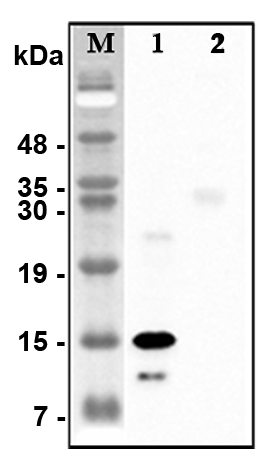
Recombinant human CTRP5 (Prod. No. AG-40A-0142) activates AMPK signaling pathway in rat L6 myoblastes. Differentiated rat L6 myoblastes were stimulated with control buffer or 0.5microg/ml recombinant human CTRP5 for 30min. The cell lysate was subjec
CTRP5 (human) (rec.) (His)
AG-40A-0142
Protein IDQ9BXJ0
Product group Proteins / Signaling Molecules
Overview
- SupplierAdipoGen Life Sciences
- Product NameCTRP5 (human) (rec.) (His)
- Delivery Days Customer10
- CertificationResearch Use Only
- Estimated Purity>90%
- Protein IDQ9BXJ0
- Protein NameComplement C1q tumor necrosis factor-related protein 5
- Scientific DescriptionCTRP5 (C1qTNF-related protein 5; C1QTNF5) belongs to a highly conserved family of adiponectin paralogs. CTRP5 mediates activation of AMP-activated protein kinase (AMPK) in muscle and liver cells, thereby regulating glucose and lipid metabolism. Serum levels of CTRP5 are significantly higher in obese/diabetic animal models compared to normal controls. Furthermore, CTRP5 may be a putative biomarker for mitochondrial dysfunction. Defects in C1QTNF5 are a cause of late-onset retinal degeneration (LORD). - Protein. Human CTRP5 (aa 16-243) is fused at the N-terminus to a His-tag. Source: E. coli. Endotoxin content: 90% (SDS-PAGE). CTRP5 (C1qTNF-related protein 5; C1QTNF5) belongs to a highly conserved family of adiponectin paralogs. CTRP5 mediates activation of AMP-activated protein kinase (AMPK) in muscle and liver cells, thereby regulating glucose and lipid metabolism. Serum levels of CTRP5 are significantly higher in obese/diabetic animal models compared to normal controls. Furthermore, CTRP5 may be a putative biomarker for mitochondrial dysfunction. Defects in C1QTNF5 are a cause of late-onset retinal degeneration (LORD).
- Storage Instruction-20°C,2°C to 8°C
- UNSPSC12352202



